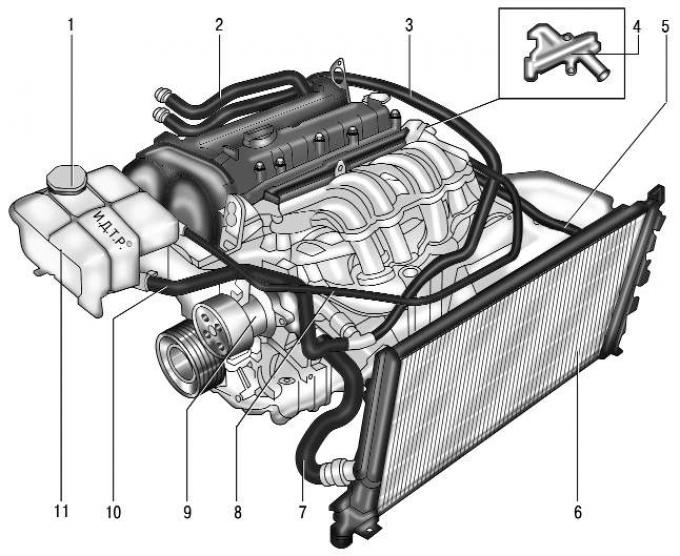
Pic. 5.12. Cooling system: 1 – a stopper of a broad tank; 2 - heater supply hose; 3 - the outlet hose of the heater; 4 - distributor housing; 5 – the inlet hose of a radiator; 6 - radiator; 7 - outlet hose of the radiator; 8 - steam outlet hose of the expansion tank; 9 - water pump; 10 – a liquid hose of a broad tank; 11 - expansion tank
Engine cooling system (pic. 5.12) liquid (with forced fluid circulation), sealed, with expansion tank.
The system is filled with ethylene glycol based liquid (antifreeze), which does not freeze at ambient temperatures down to -40°С.
Note. The procedure for replacing the coolant is described in subsection «Coolant replacement».
Attention! It is not recommended to fill the cooling system with water, as antifreeze contains anti-corrosion and anti-foaming additives, as well as additives that prevent scale build-up.
Warning! Coolant is toxic! Avoid inhalation of vapors and contact with skin.
Warning! Timely eliminate the violation of the tightness of the cooling system in order to avoid the ingress of coolant vapor into the vehicle interior during its operation. Your health is more valuable than a new cooling system pipe or a tube of sealant!
In addition to the radiator, water pump, expansion tank and hoses, the system includes a cast engine cooling jacket surrounding the cylinder walls in the block, combustion chambers and gas channels in the block head, as well as a car interior heater radiator.
The normal thermal regime of the engine is determined by the temperature of the coolant, which is maintained automatically by a thermostat in the range of 90–100°C.
Radiator with a horizontal flow of liquid, with a tubular-tape aluminum core and plastic tanks on the sides. At the bottom of the left tank is a drain valve. In the tanks there are inlet and outlet branch pipes of hoses to the water jacket of the engine.
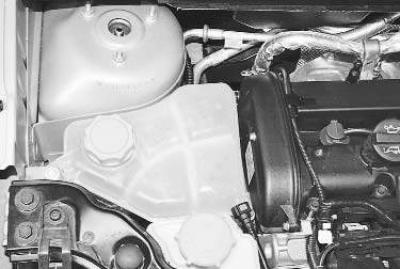
Expansion tank serves to compensate for the changing volume of the coolant depending on its temperature. The tank is made of translucent plastic. Marked on its walls «max» And «min» to control the level of the coolant, there is a filler neck on top, hermetically sealed with a plastic stopper with two valves inside it (inlet and outlet), collected in a single block. The exhaust valve opens at a pressure of 120–150 kPa (1.2–1.5 kgf/cm2), providing an increase in the temperature of the start of boiling of the coolant and preventing intense vaporization. When the liquid is cooled, its volume decreases and a vacuum is created in the system. The inlet valve in the plug opens at a vacuum of about 3 kPa (0.03 kgf/cm2) and lets air into the expansion tank.
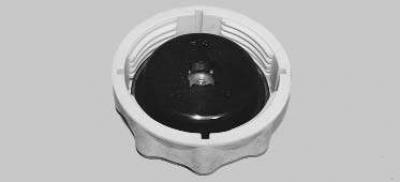
Note. The serviceability of plug valves is very important for the normal operation of the cooling system, but often when problems arise (boiling of coolant, etc.) motorists pay attention only to the operation of the thermostat, forgetting to check the valves. Leakage of the exhaust valve leads to a decrease in the boiling point of the coolant, and its jamming in the closed state leads to an emergency increase in pressure in the system, which can cause damage to the radiator and hoses.
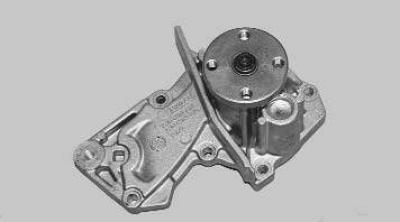
Water pump centrifugal type provides forced circulation of fluid in the cooling system, is installed on the front plane of the cylinder block and is driven from the crankshaft pulley by a V-ribbed belt for driving auxiliary units. The pump has sealed bearings that do not require relubrication. The pump cannot be repaired, therefore, in case of failure (fluid leakage or bearing damage) it is replaced as an assembly.
Thermostat with a solid temperature sensing element maintains the normal operating temperature of the coolant and reduces the warm-up time of the engine. It is installed in a special nest on the side surface of the cylinder block and is pressed against it by the body. At a coolant temperature of up to 87°C, the thermostat is completely closed and the liquid circulates through a small circuit, bypassing the radiator, which accelerates engine warm-up. At a temperature of 87°C the thermostat starts to open, and at 102°C it opens completely, providing fluid circulation through the radiator.
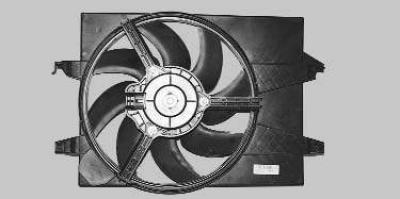
electric fan with a plastic eight-blade impeller, it ensures the radiator is blown with air at low vehicle speeds, mainly in urban areas or on mountain roads, when the oncoming air flow is insufficient to cool the radiator.
The operation of the electric fan is controlled by the electronic unit of the engine management system, which receives information from the sensors of the system. The electronic unit turns on the fan at low speed at a coolant temperature of 93°C, at high speed at 97°C, switches the fan from high speed to low at 94°C, turns it off at 90°C.
The interior heater radiator is included in the cooling system with hoses.
Visitor comments